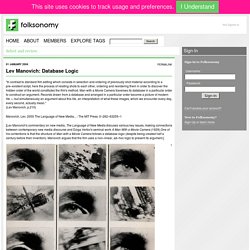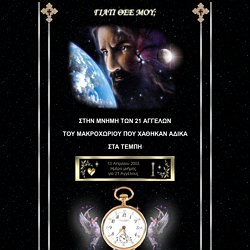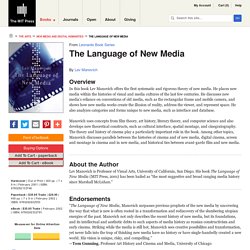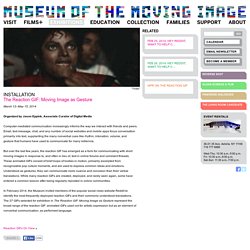

"In contrast to standard film editing which consists in selection and ordering of previously shot material according to a pre–existent script, here the process of relating shots to each other, ordering and reordering them in order to discover the hidden order of the world constitutes the film's method.

Man with a Movie Camera traverses its database in a particular order to construct an argument. Το πέρασμα από τη νεωτερικότητα στη μετανεωτερικότητα/ μεταμοντέρνο. List of 21 finest partisan movies (YU) 2. Η εποχή των μυθοπλαστικών μεγάλων αφηγήσεων 1970-1989. "moe" στοιχεία. Αντιστροφή επιφάνειας και βάθους. 13 Απριλίου 2003.

The Language of New Media. “The Language of New Media, Manovich surpasses previous prophets of the new media by uncovering the way that what is new is often rooted in a transformation and rediscovery of the slumbering utopian energies of the past.

Manovich not only describes the recent history of new media, but its foundations, and its intellectual and aesthetic debts to such aspects of media history as russian constructivism and early cinema. Striking while the media is still hot, Manovich sees creative possibilites and transformation, yet never falls into the trap of thinking new media have no history or have single-handedly created a new world. Η λογική - αισθητική της βάσης δεδομένων. Αισθητική της πληροφορίας. Η βάση δεδομένων .... το τέλος της αφήγησης; Database narrative. Βάση δεδομένων κ αφήγηση. Συνταγματικός/ παραδειγματικός. The Man with the Movie Camera(1929) Vertov. Οι χωρικές σχέσεις παίρνουν τη θέση των χρονικών διαβάσεων. Σημεία εισόδου - entry points. Untitled. Spatial Montage and Multimedia Ethnography: Using Computers to Visualise Aspects of Migration and Social Division Among a Displaced Community. Volume 11, No. 2, Art. 36 – May 2010 Spatial Montage and Multimedia Ethnography: Using Computers to Visualise Aspects of Migration and Social Division Among a Displaced Community Judith Aston Abstract: This paper discusses how computer-based techniques of spatial montage can be used to visualise aspects of migration and social division among a displaced community.

It is based on an ongoing collaboration between the author and the anthropologist, Wendy JAMES. The work is based on a substantial archive of ethnographic photographs, audio, cine and video recordings collected by JAMES in the Sudan/Ethiopian borderlands over four decades. Key words: practice-based research; visual anthropology; sensory ethnography; fieldwork recordings; academic discourse; multimedia computing; spatial montage; fluid interfaces; narrative exploration Table of Contents 1. 2. 3. 4. 5. 6. 7. 8. Acknowledgements Notes References Author Citation 1. Loop. 5consbar2_e0.gif (GIF Image, 574 × 51 pixels) Still / moving. Αλεπούδα on Twitter: "How to explain in one gif, why the loans never helped the Greek people... The Reaction GIF: Moving Image as Gesture. Organized by Jason Eppink, Associate Curator of Digital Media Computer-mediated communication increasingly informs the way we interact with friends and peers.

Email, text message, chat, and any number of social websites and mobile apps focus conversation primarily into text, supplanting the many nonverbal cues like rhythm, intonation, volume, and gesture that humans have used to communicate for many millennia. But over the last few years, the reaction GIF has emerged as a form for communicating with short moving images in response to, and often in lieu of, text in online forums and comment threads. Untitled. Ψηφιακά περιβάλλοντα.
Tagging & Folksonomy. WW2 Tweets from 1940 (RealTimeWWII) Oscars 2016: The Year Minorities are Speaking Out (with images, tweets) · LysiaF. Retelling history, 140 characters at a time - CNET. Spoiler alert: The Cuban Missile Crisis ended without the United States and the Soviet Union launching even a single nuclear weapon, and the Allies won World War II.

You're no doubt well aware of those ultimate outcomes, but what if you don't remember, or never knew, the myriad individual moments, big and small, that led to those famous conclusions? There are plenty of thick history books you could pick up, but maybe you're someone who wants a more dramatic sense of what happened -- even, perhaps, to feel like you're right in the thick of the drama.
To be sure, there's no time machine that can take you back to London during The Blitz, or to the White House Situation Room as JFK stood firm against belligerent military leaders wanting to engage the Soviets over surreptitiously putting nukes in Cuba. But these days, in little 140-character snippets, many of those moments are being played out for the whole world to see. And if you close your eyes, you can almost imagine you're there. Mashable. We're constantly amazed by how the communication of news has changed over the past decade alone.

A top NATO commander announced the end of the Libyan mission on Facebook, news of Osama Bin Laden's death set a Twitter record, and news, photos and video of the Occupy Wall Street movement has spread like wildfire over social media. SEE ALSO: We Hold These Tweets To Be Self-Evident [COMIC] Trump Twitter Archive. Nanoism: a place for twitter-fiction. Paul Otlet, visioning a web in 1934. Untitled. Witness 360: 7/7 - virtual reality video.